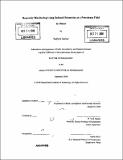| dc.contributor.advisor | M. Nafi Toksöz. | en_US |
| dc.contributor.author | Sarkar, Sudipta | en_US |
| dc.contributor.other | Massachusetts Institute of Technology. Dept. of Earth, Atmospheric, and Planetary Sciences. | en_US |
| dc.coverage.spatial | a-mk--- | en_US |
| dc.date.accessioned | 2009-06-30T16:14:25Z | |
| dc.date.available | 2009-06-30T16:14:25Z | |
| dc.date.copyright | 2008 | en_US |
| dc.date.issued | 2008 | en_US |
| dc.identifier.uri | http://hdl.handle.net/1721.1/45765 | |
| dc.description | Thesis (Ph. D.)--Massachusetts Institute of Technology, Dept. of Earth, Atmospheric, and Planetary Sciences, 2008. | en_US |
| dc.description | Includes bibliographical references. | en_US |
| dc.description.abstract | This thesis presents methods of analysis and results from a petroleum reservoir monitoring application using induced seismicity data. The dissertation work is comprised of four major studies, each focusing on a different aspect of induced seismicity. First, methods and issues in location of induced seismicity are discussed, and strategies are proposed for determining accurate hypocenters of induced events. The importance of velocity model and how it impacts the depth determination of reservoir-induced events are demonstrated with real field data. A location method that is better-suited than other existing methods for this application is proposed. The accuracy and efficiency of this proposed location method is demonstrated with field data application.Secondly, event locations and interpretations are presented for about 1300 induced events recorded by a near-surface network over a seven year period at a petroleum field in Oman. The event hypocenters delineate two major northeast-southwest striking faults in the field, which are consistent with fault maps derived from reflection seismic interpretations. Spatiotemporal analysis of induced event locations reveals ongoing large scale fault reactivation in the field, and also suggests compaction of the gas reservoir as the major cause and water injection in the oil reservoir as the secondary cause for inducing seismicity in the field.Thirdly, event locations and interpretations are presented for a different set of induced seismicity data recorded by a deep-borehole network over an 11-month period at the same field. About 5400 events are located and analyzed, and detailed mapping of faults and fractures using the event hypocenters are presented. | en_US |
| dc.description.abstract | (cont.) Patterns of seismicity also reveal faults and fracture systems previously unmapped by reflection seismic. While this dataset allows for much finer interpretation, the results between the two network data are found to be consistent and comparable.Finally, the double-difference relocation and tomography method is applied for event relocation and imaging of the reservoir. Better correlation of relocated events with faults is observed from application of this method to the surface-network events, and detailed velocity and structure images for the reservoir are obtained from application of tomography with the deep network events. | en_US |
| dc.description.statementofresponsibility | by Sudipta Sarkar. | en_US |
| dc.format.extent | 260 p. | en_US |
| dc.language.iso | eng | en_US |
| dc.publisher | Massachusetts Institute of Technology | en_US |
| dc.rights | M.I.T. theses are protected by
copyright. They may be viewed from this source for any purpose, but
reproduction or distribution in any format is prohibited without written
permission. See provided URL for inquiries about permission. | en_US |
| dc.rights.uri | http://dspace.mit.edu/handle/1721.1/7582 | en_US |
| dc.subject | Earth, Atmospheric, and Planetary Sciences. | en_US |
| dc.title | Reservoir monitoring using induced seismicity at a petroleum field in Oman | en_US |
| dc.type | Thesis | en_US |
| dc.description.degree | Ph.D. | en_US |
| dc.contributor.department | Massachusetts Institute of Technology. Department of Earth, Atmospheric, and Planetary Sciences | |
| dc.identifier.oclc | 318364487 | en_US |
